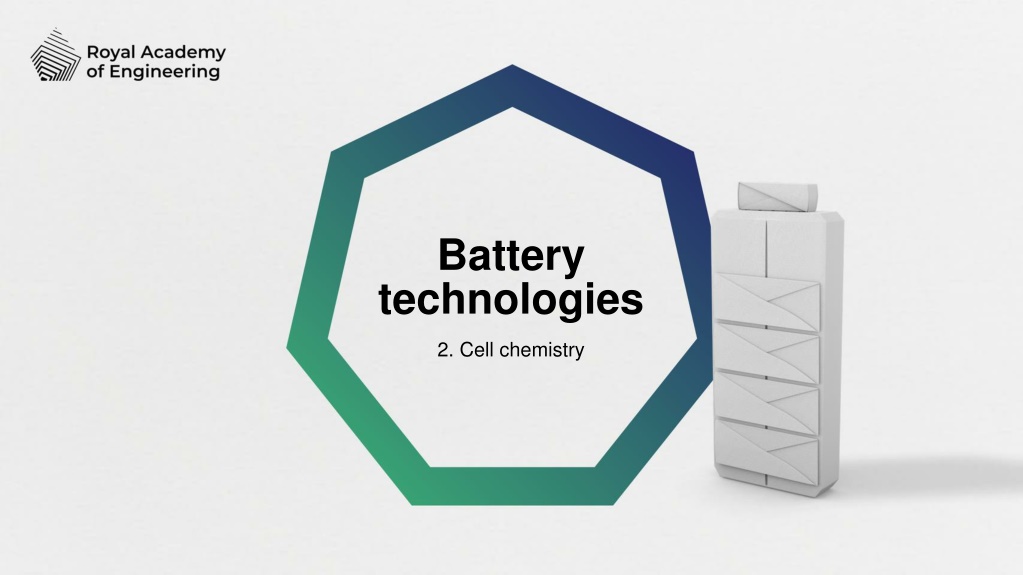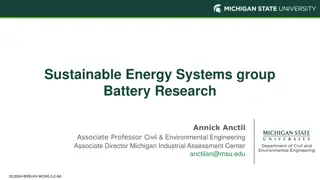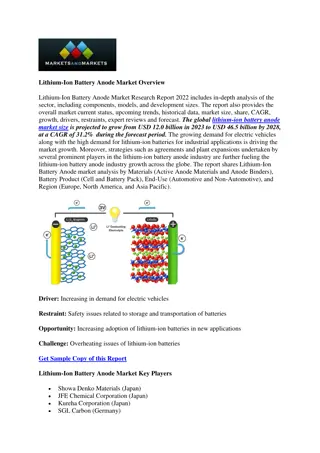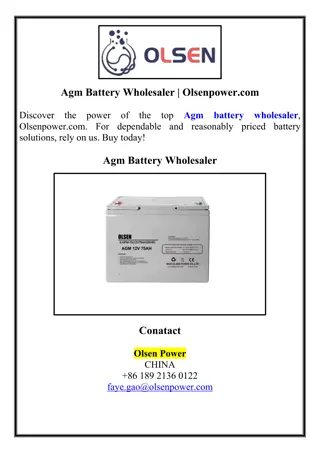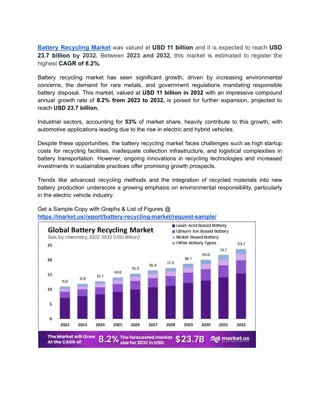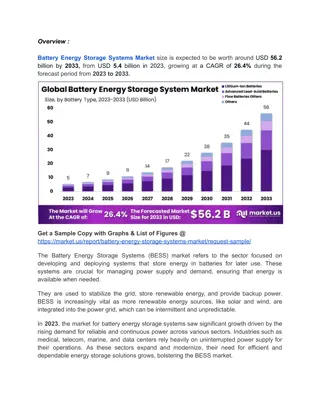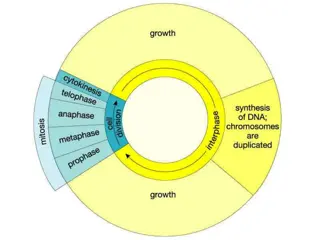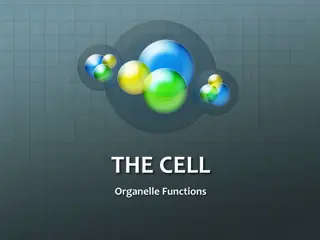Battery technologies: 2. Cell chemistry
Explore the workings of simple electrical cells, their components, and the conversion of chemical energy into electrical energy. Learn about different cell types, primary vs. secondary cells, and the process of recharging. Discover examples of cells like Alkaline, Zinc, NiCad, NiMH, and Lithium-ion, and understand the differences between them through real-life experiences. Dive into the factors that determine the advantages of various cell types and their energy densities.
Download Presentation

Please find below an Image/Link to download the presentation.
The content on the website is provided AS IS for your information and personal use only. It may not be sold, licensed, or shared on other websites without obtaining consent from the author.If you encounter any issues during the download, it is possible that the publisher has removed the file from their server.
You are allowed to download the files provided on this website for personal or commercial use, subject to the condition that they are used lawfully. All files are the property of their respective owners.
The content on the website is provided AS IS for your information and personal use only. It may not be sold, licensed, or shared on other websites without obtaining consent from the author.
E N D
Presentation Transcript
Battery technologies 2. Cell chemistry
2. Cell chemistry Learning outcomes You will be able to: Describe how a simple electrical cell produces electricity. Describe the parts of a basic electrical cell. Analyse the energy density of different cell types and use this to explain their relative advantages. Identify how primary and secondary cell discharge characteristics vary, linking this to applications. Explain the difference between primary and secondary cells. 3
2. Cell chemistry 4 What happens in a cell? A cell converts stored chemical energy into electrical energy. What happens when a cell is connected in a complete circuit, for example, to an LED? Any simple cell includes a cathode, anode and electrolyte. The cathode and anode are made of different metals, for example manganese and zinc. The use of different metals creates a potential difference (voltage) across the cell. Given your answer, what do you think must happen inside the cell? The electrolyte is a solution or paste that can conduct electricity. Can what happens inside the cell continue indefinitely, and what evidence supports your answer? Anode Cathode Electrolyte 4
2. Cell chemistry 5 What happens in a cell? When the cell is connected in a complete circuit a current flows through the wire and the LED lights up. This means that the current must also flow within the cell. The electrolyte enables this to happen. A reaction takes place within the cell between the anode and cathode, which releases the cell s stored chemical energy. This reaction can t continue indefinitely. The cell only works until the stored chemical energy is used up and the reaction stops. 5
2. Cell chemistry 6 Examples of cells Alkaline Zinc Nickel cadmium (NiCad) Nickel metal hydride (NiMH) Lithium ion (Li) NiCad Long life NiMH Li Which of these cell types are familiar to you? Can you use your real-life experiences to divide them into two types of cell? What difference explains your choices? 6
2. Cell chemistry Primary v secondary cells The difference is whether the cells are used once or can be recharged. In any cell a voltage and electric current will be produced until the reaction can no longer continue. The cell is discharged. When a zinc or alkaline cell is discharged it can t be recharged: this is a primary cell. A NiCad, NiMH or lithium ion cell can be recharged: this is a secondary cell. Zinc or alkaline cells use one-way chemical reactions to produce electricity. What kind of reaction do you think happens inside secondary cells? What does it therefore mean to recharge a cell? What energy source provides this ability to recharge? 7
2. Cell chemistry Characteristics of primary v secondary cells An engineer wants to know whether to use a lithium or alkaline cell to power a handheld measurement device. They carry out an investigation to find out how each type of cell discharges over time. They connect each type of cell to an identical load and measure the voltage across the load every 10 minutes. Load voltage as % of maximum Time mins Lithium % Alkaline % 10 98 95 The table shows how each cell s voltage declines over time. Note that this is as a percentage of the maximum value. The engineer knows that rechargeable cells can have a lower terminal voltage, for example rechargeable AA cells are 1.2 V instead of 1.5 V, which can limit certain uses. 20 96 82 30 92 70 40 89 58 50 86 45 60 82 33 Plot a line graph to compare how each cell discharges over time. 70 74 18 80 0 0 Describe the difference and suggest how an engineer might use this information when selecting cells to power a device. Would you use lithium or alkaline cells to power a TV remote or cordless drill? Justify your answers. 8
2. Cell chemistry Characteristics of primary v secondary cells Lithium Alkaline The graph shows that lithium cells retain a much higher working voltage as they discharge, while alkaline cells lose voltage steadily. 100 % of maximum Voltage Lithium cells are suitable for devices where it is important to always provide as close to the working voltage as possible, for example when powering a DC motor. 75 50 Alkaline cells are suitable for non-critical applications like a TV remote. 25 Lithium cells are more suitable for critical or motor applications like cordless drills, drones, electric vehicles (EVs) or autonomous guided vehicles. 0 0 20 40 60 80 Time (mins) EV batteries need to output a consistent voltage to maintain speed, but what cell factor will affect the range of the vehicle? How does this link to the overall design of the vehicle? 9
2. Cell chemistry Energy densities of secondary cells A key innovation in secondary cells has been to increase their energy density, measured as the energy available per unit of mass or volume. Lithium polymer Lithium phosphate 250 This matters for EVs as better energy density delivers more range, and more energy-dense battery packs take up less volume within the car. 200 Watt-hours/kilogram Nickel cadmium Lithium ion 150 Lead acid 100 Describe how the energy density of lead acid, nickel metal hydride and lithium polymer cells differs. Nickel metal hydride 50 Why do you think nickel metal hydride cells have replaced nickel cadmium cells? 0 In total, roughly how much more energy-dense is a lithium polymer cell per litre, compared with a lead-acid cell? 0 50 100 150 200 250 300 350 400 450 Watt-hours/litre 10
2. Cell chemistry Case study: freeze-thaw cell chemistry A new freeze-thaw cell technology may make long-term, seasonal energy storage possible. The cell s electrolyte is a type of salt that is liquid at 180 C but solid at room temperature. The cell is heated before being charged. When the cell cools the electrolyte solidifies, effectively locking up the energy until needed. When needed, the cell is heated to allow a current to flow. The technology is at an early stage of development but in laboratory tests a freeze-thaw cell has retained 92% of its capacity for three months. What do you think happens to the electrolyte ions during the freeze-thaw process? How might this type of cell make renewable energy more available over seasonal periods of time? 11
2. Cell chemistry Case study: flow batteries Flow batteries store energy in tanks of liquid electrolytes made of iron salts. To store energy inside the cell, one electrolyte is pumped past a positive electrode, depositing iron, and the other past a negative electrode, gaining electrons. This can store large amounts of chemical energy over long periods. Catholyte tank Anolyte tank To produce electricity, the direction of the pumps is reversed so the electrolytes flow in the reverse direction past the electrodes, producing a current. These cells have low energy density but use much safer chemistry than lithium-ion cells. Because the energy is stored in the electrolyte, to increase a flow battery s storage capacity, engineers just increase the size of the electrolyte storage. What applications might benefit from this form of energy storage? Pump Can you suggest how this concept might one day be adapted for electric vehicles? Ion-selective membrane 12
2. Cell chemistry New cell technologies and engineering Katrina Henry Maintenance engineer EV technician How might each engineer s role be changed as new cell technologies come to market? I maintain the automated warehouse vehicles in a busy warehouse. I convert classic cars from petrol to EV systems. Vicky Recycling engineer Samira Jamal Power engineer Home renewables I develop new ways to recycle precious materials, including the rare earth metals used in modern secondary cells. I design the systems that respond to short-term peaks in demand. I install home solar power generation and storage. 13
2. Cell chemistry Learning outcomes You will be able to: Describe how a simple electrical cell produces electricity. Describe the parts of a basic electrical cell. Analyse the energy density of different cell types and use this to explain their relative advantages. Identify how primary and secondary cell discharge characteristics vary, linking this to applications. Explain the difference between primary and secondary cells. 14
